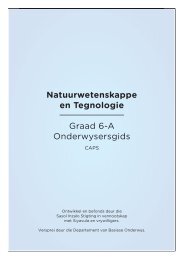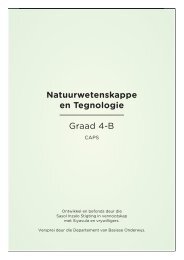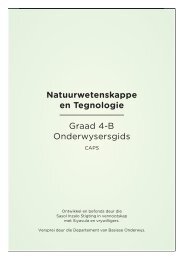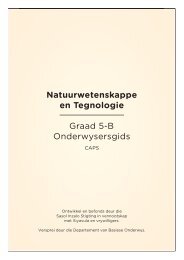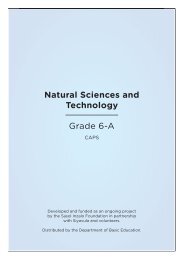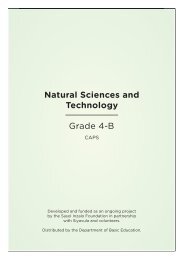Natural Sciences and Technology Grade 5-B ... - Thunderbolt Kids
Natural Sciences and Technology Grade 5-B ... - Thunderbolt Kids
Natural Sciences and Technology Grade 5-B ... - Thunderbolt Kids
Create successful ePaper yourself
Turn your PDF publications into a flip-book with our unique Google optimized e-Paper software.
3 Sedimentary rocks<br />
VISIT<br />
Dierent rock types<br />
(video)<br />
goo.gl/yD3qd<br />
126<br />
KEY QUESTIONS<br />
• Why does the Earth have mountains <strong>and</strong> valleys?<br />
• Have mountains always looked like they look now?<br />
• Why can you sometimes see "layers" in rock which<br />
are dierent colours? How did these layers form?<br />
Teacher's Note<br />
Chapter 3 deals with one kind of rock - sedimentary rock. This<br />
does leave one wondering what other types of rock there are. The<br />
main other type of rock is igneous rock. That is rock that has been<br />
hot <strong>and</strong> molten, <strong>and</strong> pushed up from deep in the mantle. Mostly it<br />
hardens under the ground <strong>and</strong> we see it only millions of years later<br />
when erosion has removed the ground over it. Sometimes it breaks<br />
through the crust as molten lava, <strong>and</strong> we have a volcano. The top<br />
of the Drakensberg is the remains of ahuge outpouring oflava<br />
long ago. Nature is always breaking down rock <strong>and</strong> eroding it, so<br />
mountains are always changing. They change so slowly that we<br />
cannot notice it in aperson's lifetime, but the changes are<br />
happening all the time.<br />
We saw in Chapter 2 that the surface of the Earth is made up of<br />
rocks <strong>and</strong> soil. There are dierent soil types, but did you know that<br />
there are also dierent types of rock? We classify rocks depending<br />
on how they were formed.<br />
We are only going to look at Sedimentary rock in this chapter <strong>and</strong><br />
find out how it is formed <strong>and</strong> used.<br />
3.1 Formation of sedimentary rock<br />
In Chapter 2, we saw how rocks break up into smaller <strong>and</strong> smaller<br />
pieces, until we have grains of s<strong>and</strong>. Now we find out what<br />
happens to the s<strong>and</strong>.



